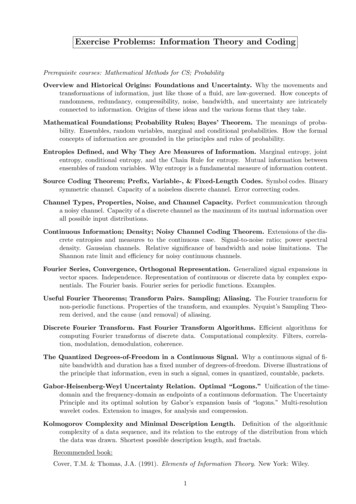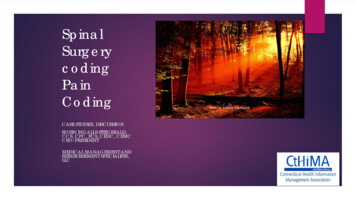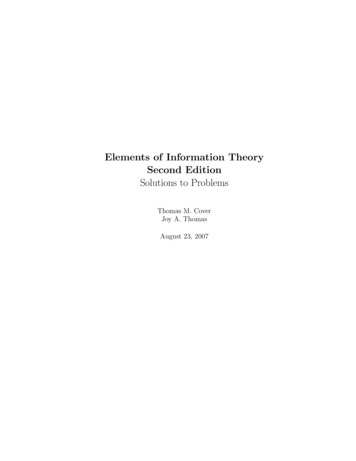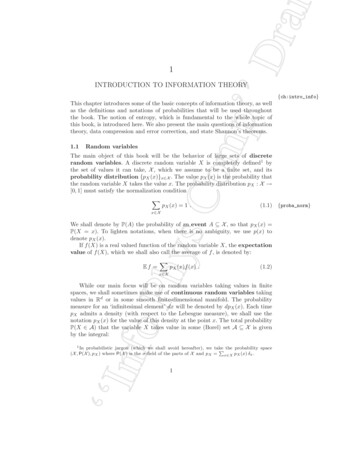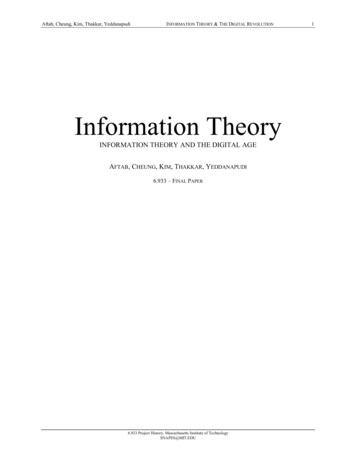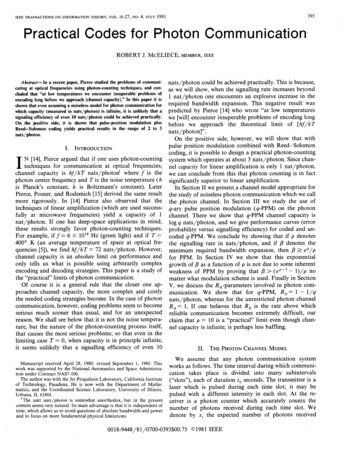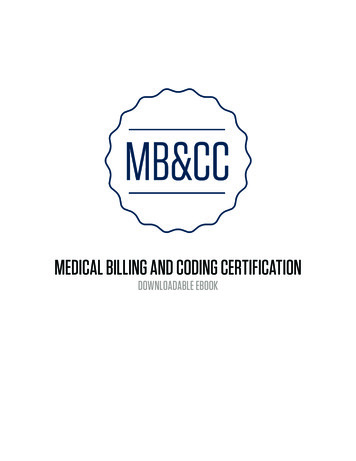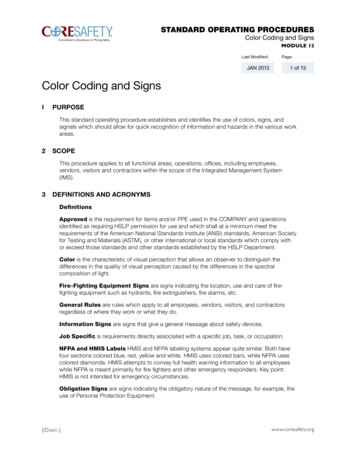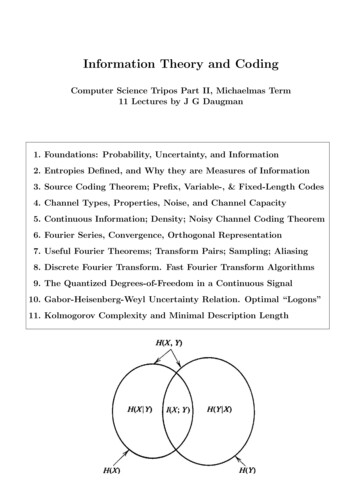
Transcription
Information Theory and CodingComputer Science Tripos Part II, Michaelmas Term11 Lectures by J G Daugman1. Foundations: Probability, Uncertainty, and Information2. Entropies Defined, and Why they are Measures of Information3. Source Coding Theorem; Prefix, Variable-, & Fixed-Length Codes4. Channel Types, Properties, Noise, and Channel Capacity5. Continuous Information; Density; Noisy Channel Coding Theorem6. Fourier Series, Convergence, Orthogonal Representation7. Useful Fourier Theorems; Transform Pairs; Sampling; Aliasing8. Discrete Fourier Transform. Fast Fourier Transform Algorithms9. The Quantized Degrees-of-Freedom in a Continuous Signal10. Gabor-Heisenberg-Weyl Uncertainty Relation. Optimal “Logons”11. Kolmogorov Complexity and Minimal Description Length
Information Theory and CodingJ G DaugmanPrerequisite courses: Probability; Mathematical Methods for CS; Discrete MathematicsAimsThe aims of this course are to introduce the principles and applications of information theory.The course will study how information is measured in terms of probability and entropy, and therelationships among conditional and joint entropies; how these are used to calculate the capacityof a communication channel, with and without noise; coding schemes, including error correctingcodes; how discrete channels and measures of information generalise to their continuous forms;the Fourier perspective; and extensions to wavelets, complexity, compression, and efficient codingof audio-visual information.Lectures Foundations: probability, uncertainty, information. How concepts of randomness,redundancy, compressibility, noise, bandwidth, and uncertainty are related to information.Ensembles, random variables, marginal and conditional probabilities. How the metrics ofinformation are grounded in the rules of probability. Entropies defined, and why they are measures of information. Marginal entropy,joint entropy, conditional entropy, and the Chain Rule for entropy. Mutual informationbetween ensembles of random variables. Why entropy is the fundamental measure of information content. Source coding theorem; prefix, variable-, and fixed-length codes. Symbol codes.The binary symmetric channel. Capacity of a noiseless discrete channel. Error correctingcodes. Channel types, properties, noise, and channel capacity. Perfect communicationthrough a noisy channel. Capacity of a discrete channel as the maximum of its mutualinformation over all possible input distributions. Continuous information; density; noisy channel coding theorem. Extensions of thediscrete entropies and measures to the continuous case. Signal-to-noise ratio; power spectraldensity. Gaussian channels. Relative significance of bandwidth and noise limitations. TheShannon rate limit and efficiency for noisy continuous channels. Fourier series, convergence, orthogonal representation. Generalised signal expansions in vector spaces. Independence. Representation of continuous or discrete data bycomplex exponentials. The Fourier basis. Fourier series for periodic functions. Examples. Useful Fourier theorems; transform pairs. Sampling; aliasing. The Fourier transform for non-periodic functions. Properties of the transform, and examples. Nyquist’sSampling Theorem derived, and the cause (and removal) of aliasing. Discrete Fourier transform. Fast Fourier Transform Algorithms. Efficient algorithms for computing Fourier transforms of discrete data. Computational complexity.Filters, correlation, modulation, demodulation, coherence.
The quantised degrees-of-freedom in a continuous signal. Why a continuous signal of finite bandwidth and duration has a fixed number of degrees-of-freedom. Diverseillustrations of the principle that information, even in such a signal, comes in quantised,countable, packets. Gabor-Heisenberg-Weyl uncertainty relation. Optimal “Logons”. Unification ofthe time-domain and the frequency-domain as endpoints of a continuous deformation. TheUncertainty Principle and its optimal solution by Gabor’s expansion basis of “logons”.Multi-resolution wavelet codes. Extension to images, for analysis and compression. Kolmogorov complexity. Minimal description length. Definition of the algorithmiccomplexity of a data sequence, and its relation to the entropy of the distribution fromwhich the data was drawn. Fractals. Minimal description length, and why this measure ofcomplexity is not computable.ObjectivesAt the end of the course students should be able to calculate the information content of a random variable from its probability distribution relate the joint, conditional, and marginal entropies of variables in terms of their coupledprobabilities define channel capacities and properties using Shannon’s Theorems construct efficient codes for data on imperfect communication channels generalise the discrete concepts to continuous signals on continuous channels understand Fourier Transforms and the main ideas of efficient algorithms for them describe the information resolution and compression properties of waveletsRecommended book* Cover, T.M. & Thomas, J.A. (1991). Elements of information theory. New York: Wiley.
Information Theory and CodingComputer Science Tripos Part II, Michaelmas Term11 lectures by J G Daugman1. Overview: What is Information Theory?Key idea: The movements and transformations of information, just likethose of a fluid, are constrained by mathematical and physical laws.These laws have deep connections with: probability theory, statistics, and combinatorics thermodynamics (statistical physics) spectral analysis, Fourier (and other) transforms sampling theory, prediction, estimation theory electrical engineering (bandwidth; signal-to-noise ratio) complexity theory (minimal description length) signal processing, representation, compressibilityAs such, information theory addresses and answers thetwo fundamental questions of communication theory:1. What is the ultimate data compression?(answer: the entropy of the data, H, is its compression limit.)2. What is the ultimate transmission rate of communication?(answer: the channel capacity, C, is its rate limit.)All communication schemes lie in between these two limits on the compressibility of data and the capacity of a channel. Information theorycan suggest means to achieve these theoretical limits. But the subjectalso extends far beyond communication theory.1
Important questions. to which Information Theory offers answers: How should information be measured? How much additional information is gained by some reduction inuncertainty? How do the a priori probabilities of possible messages determinethe informativeness of receiving them? What is the information content of a random variable? How does the noise level in a communication channel limit itscapacity to transmit information? How does the bandwidth (in cycles/second) of a communicationchannel limit its capacity to transmit information? By what formalism should prior knowledge be combined withincoming data to draw formally justifiable inferences from both? How much information in contained in a strand of DNA? How much information is there in the firing pattern of a neurone?Historical origins and important contributions: Ludwig BOLTZMANN (1844-1906), physicist, showed in 1877 thatthermodynamic entropy (defined as the energy of a statistical ensemble [such as a gas] divided by its temperature: ergs/degree) isrelated to the statistical distribution of molecular configurations,with increasing entropy corresponding to increasing randomness. Hemade this relationship precise with his famous formula S k log Wwhere S defines entropy, W is the total number of possible molecular configurations, and k is the constant which bears Boltzmann’sname: k 1.38 x 10 16 ergs per degree centigrade. (The aboveformula appears as an epitaph on Boltzmann’s tombstone.) This is2
equivalent to the definition of the information (“negentropy”) in anensemble, all of whose possible states are equiprobable, but with aminus sign in front (and when the logarithm is base 2, k 1.) Thedeep connections between Information Theory and that branch ofphysics concerned with thermodynamics and statistical mechanics,hinge upon Boltzmann’s work. Leo SZILARD (1898-1964) in 1929 identified entropy with information. He formulated key information-theoretic concepts to solve thethermodynamic paradox known as “Maxwell’s demon” (a thoughtexperiment about gas molecules in a partitioned box) by showingthat the amount of information required by the demon about thepositions and velocities of the molecules was equal (negatively) tothe demon’s entropy increment. James Clerk MAXWELL (1831-1879) originated the paradox called“Maxwell’s Demon” which greatly influenced Boltzmann and whichled to the watershed insight for information theory contributed bySzilard. At Cambridge, Maxwell founded the Cavendish Laboratorywhich became the original Department of Physics. R V HARTLEY in 1928 founded communication theory with hispaper Transmission of Information. He proposed that a signal(or a communication channel) having bandwidth Ω over a durationT has a limited number of degrees-of-freedom, namely 2ΩT , andtherefore it can communicate at most this quantity of information.He also defined the information content of an equiprobable ensembleof N possible states as equal to log2 N . Norbert WIENER (1894-1964) unified information theory and Fourieranalysis by deriving a series of relationships between the two. Heinvented “white noise analysis” of non-linear systems, and made thedefinitive contribution to modeling and describing the informationcontent of stochastic processes known as Time Series.3
Dennis GABOR (1900-1979) crystallized Hartley’s insight by formulating a general Uncertainty Principle for information, expressingthe trade-off for resolution between bandwidth and time. (Signalsthat are well specified in frequency content must be poorly localizedin time, and those that are well localized in time must be poorlyspecified in frequency content.) He formalized the “Information Diagram” to describe this fundamental trade-off, and derived the continuous family of functions which optimize (minimize) the conjointuncertainty relation. In 1974 Gabor won the Nobel Prize in Physicsfor his work in Fourier optics, including the invention of holography. Claude SHANNON (together with Warren WEAVER) in 1949 wrotethe definitive, classic, work in information theory: MathematicalTheory of Communication. Divided into separate treatments forcontinuous-time and discrete-time signals, systems, and channels,this book laid out all of the key concepts and relationships that define the field today. In particular, he proved the famous Source Coding Theorem and the Noisy Channel Coding Theorem, plus manyother related results about channel capacity. S KULLBACK and R A LEIBLER (1951) defined relative entropy(also called information for discrimination, or K-L Distance.) E T JAYNES (since 1957) developed maximum entropy methodsfor inference, hypothesis-testing, and decision-making, based on thephysics of statistical mechanics. Others have inquired whether theseprinciples impose fundamental physical limits to computation itself. A N KOLMOGOROV in 1965 proposed that the complexity of astring of data can be defined by the length of the shortest binaryprogram for computing the string. Thus the complexity of datais its minimal description length, and this specifies the ultimatecompressibility of data. The “Kolmogorov complexity” K of a stringis approximately equal to its Shannon entropy H, thereby unifyingthe theory of descriptive complexity and information theory.4
2. Mathematical Foundations; Probability Rules;Bayes’ TheoremWhat are random variables? What is probability?Random variables are variables that take on values determined by probability distributions. They may be discrete or continuous, in either theirdomain or their range. For example, a stream of ASCII encoded textcharacters in a transmitted message is a discrete random variable, witha known probability distribution for any given natural language. Ananalog speech signal represented by a voltage or sound pressure waveform as a function of time (perhaps with added noise), is a continuousrandom variable having a continuous probability density function.Most of Information Theory involves probability distributions of random variables, and conjoint or conditional probabilities defined overensembles of random variables. Indeed, the information content of asymbol or event is defined by its (im)probability. Classically, there aretwo different points of view about what probability actually means: relative frequency: sample the random variable a great many timesand tally up the fraction of times that each of its different possiblevalues occurs, to arrive at the probability of each. degree-of-belief: probability is the plausibility of a proposition orthe likelihood that a particular state (or value of a random variable)might occur, even if its outcome can only be decided once (e.g. theoutcome of a particular horse-race).The first view, the “frequentist” or operationalist view, is the one thatpredominates in statistics and in information theory. However, by nomeans does it capture the full meaning of probability. For example,the proposition that "The moon is made of green cheese" is onewhich surely has a probability that we should be able to attach to it.We could assess its probability by degree-of-belief calculations which5
combine our prior knowledge about physics, geology, and dairy products. Yet the “frequentist” definition of probability could only assigna probability to this proposition by performing (say) a large numberof repeated trips to the moon, and tallying up the fraction of trips onwhich the moon turned out to be a dairy product.In either case, it seems sensible that the less probable an event is, themore information is gained by noting its occurrence. (S
Information Theory and Coding Computer Science Tripos Part II, Michaelmas Term 11 Lectures by J G Daugman 1. Foundations: Probability, Uncertainty, and Information 2. Entropies De ned, and Why they are Measures of Information 3. Source Coding Theorem; Pre x, Variable-, & Fixed-Length Codes 4. Channel Types, Properties, Noise, and Channel Capacity 5. Continuous Information; Density; Noisy .
